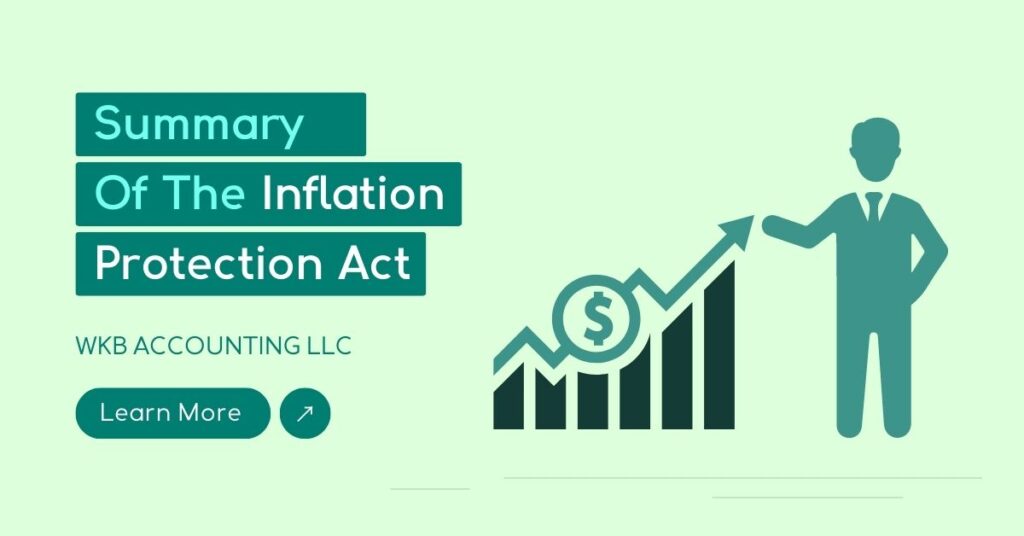Summary Of The Inflation Protection Act
Recently, the U.S. House of Representatives held a vote on the Inflation Reduction Act, which passed by a count of 220-207. The bill was then put forth to be signed into law by President Biden. The purpose of this piece of legislation is to make sizable investments into everything from prescription drug costs and health care to climate change. This guide offers an in-depth summary of the inflation reduction act and what it means for you.
What Is the Inflation Reduction Act?

The Inflation Reduction Act was passed in the U.S. Senate before being passed in the U.S. House. The bill itself was formed only after months of negotiations and discussions among politicians in the U.S. Senate. During that time, the bill took many different forms and included a wide range of provisions, some of which would eventually be taken out of the bill.
Now that the Inflation Reduction Act has formally passed, the primary benefits of this bill have been identified. Over the next 10 years, around $300 billion is set to be invested in deficit reduction. Another $369 billion will be invested in climate-change and energy-security programs, which makes this among the largest climate investments in the history of the U.S. Additional components of this bill include a 15% tax on corporations that make over $1 billion in total profits as well as health care subsidies that millions of people can take advantage of.
The Inflation Reduction Act was originally known as the Build Back Better Act before it was pared down and retooled with a focus on climate change and inflation reduction. Among the most notable aspects of this bill is the inclusion of cash incentives that electric vehicle consumers can obtain.
Also read – MAKING THE MOST OUT OF YOUR QUALIFIED BUSINESS INCOME DEDUCTION
A portion of the climate funding is going towards cities and native American communities that are substantially affected by these issues. The costs associated with the bill are expected to be mostly covered by the aforementioned tax rate. Another measure that was set to be attached would have reduced the carried interest tax to make sure that hedge fund managers paid 37% in tax as opposed to 20%. However, this measure was eliminated to ensure the bill passed the U.S. Senate.
Primary Details About the Inflation Reduction Act
The most important components of the Inflation reduction Act include:
- A 15% minimum tax rate on corporations
- Prescription drug price reform
- ACA subsidy extension
- IRS tax enforcement
- Climate change investments
The 15% corporate tax rate only applies to corporations that make more than $1 billion in annual income. Individuals and households aren’t set to have a higher tax rate. Any stock buybacks that corporations perform will come with an excise tax that amounts to 1%.
As for the prescription drug price reform, this is considered to be among the most beneficial aspects of the Inflation Reduction Act. This reform allows Medicare to effectively negotiate prescription drug prices, which means that beneficiaries won’t need to pay as much to receive essential medications. Starting in 2025, a cap of $2,000 has been set for out-of-pocket costs on prescription drugs.
The subsidy extension pertaining to the Affordable Care Act relates to subsidies that the federal government currently provides to reduce monthly premiums for lower-income individuals. Initially, these subsidies would have expired at the end of 2022 but are now extended until the end of 2025. Around three million Americans currently receive subsidies for health insurance every year.
Also read – How much can I expect from social security retirement benefits
The IRS has been underfunded for many years. This bill is set to provide the Internal Revenue Service with $80 billion in funds that will be spread out over 10 years and will focus on providing funding for many different aspects of the agency.
When looking specifically at the climate change investments mentioned previously, the bill provides investments for climate protection, household tax credits to reduce energy costs, and clean energy production. It’s estimated that the bill will result in a reduction of carbon emissions by upwards of 40% by 2030.
Many of the measures in the Inflation Reduction Act will be introduced over an extended period of time or may only begin in 2025. If you intend on purchasing an electric vehicle in the near future, you may qualify for a $7,500 subsidy to reduce costs. Now that the bill is being signed into law, it should become even clearer over the next few months how impactful the Inflation Reduction Act will be.
Thanks you for reading, if you have a minute to leave a short review on Google it would be greatly appreciated – Please Share a Review here